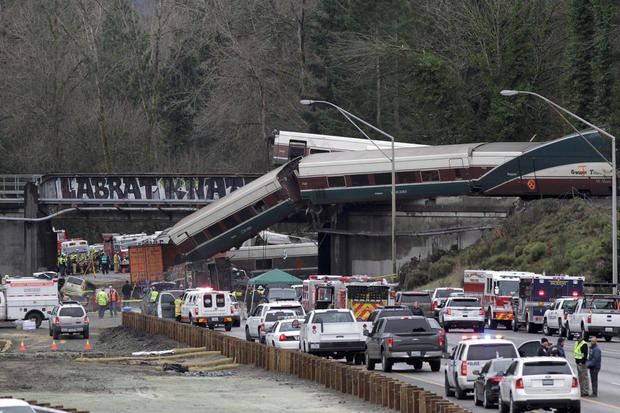Technology exists that could have prevented the deadly train derailment in DuPont, Washington, Monday. Amtrak and all big passenger railroads were supposed to have it in place two years ago, but that didn’t happen.
So when Amtrak 501 came into a curving stretch of track at nearly triple the posted speed limit, that’s a scenario positive train control, or PTC, is designed to prevent. It uses sensors along the tracks to communicate with locomotives.
Last year, Chris Jagodzinski with Amtrak showed CBS News how the technology takes over a speeding train. He explained that if a train tried to accelerate, PTC wouldn’t let that happen.
“Traction is locked, I can’t do it,” Jagodzinski said. “So even if I tried, I have no power because the brakes are applied.”
A deadly 2008 accident in California prompted Congress to mandate PTC by the end of 2015. But that year, just months after the Amtrak 188 derailment in Philadelphia, Congress voted to delay the deadline until 2018.
Now, only about 40 percent of passenger locomotives have PTC installed. “People have died as a result of that extension,” said Mark Rosenker, the former chair for the National Transportation Safety Board in 2008.

The scene where an Amtrak passenger train derailed on a bridge over interstate highway I-5 in DuPont, Washington, U.S. December 18, 2017.
Steve Dipaola/REUTERS
“Railroads basically went to Congress and said, ‘We’re not going to operate unless we get relief,'” said Rosenker. “You couldn’t just stop America’s railroads. Congress caved in.”
This year, the Trump administration has delayed five times a requirement for passenger railroads to develop a system-wide safety plan. It has also abandoned stricter sleep apnea testing rules, despite a series of deadly crashes, and against NTSB recommendations.
“Some of the actions by this administration are definitely moving us backward, and not forward, in having a safer rail system,” said Matthew Lehner, the Federal Railroad Administration’s spokesman under former President Obama.
The current Department of Transportation explained that in terms of safety, they needed more time to review comments, with reference to sleep apnea. They said they felt existing safety programs and other regulations would be sufficient.
© 2017 CBS Interactive Inc. All Rights Reserved.
